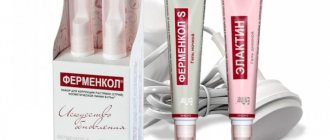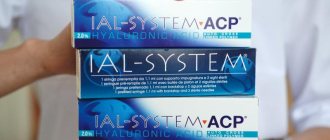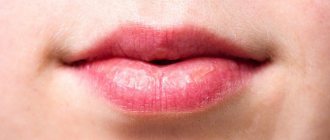Cheilitis is an isolated inflammatory process in the area of the mucous membrane, skin and red border of the lips. Outwardly it looks like swelling with redness and peeling of tissue. It can be an independent disease or a symptomatic manifestation of other pathologies. Sooner or later, almost every person encounters it, but at a young age the disease is noticeably milder, recurs less often and has no complications. In older people, due to a weakened immune system, periodic relapses of cheilitis can cause malignant tissue degeneration.
Causes
Cheilitis is a polymorphic and multifactorial disease that can be triggered by infections, physical and chemical environmental factors, as well as internal characteristics of the body. Among them:
- constant exposure to the open air - inflammation and peeling of the lips occurs when chapped by hot or cold air, excessive insolation;
- the presence of chronic diseases with skin manifestations of symptoms - various types of dermatitis, psoriasis, lupus erythematosus, lichen planus, syphilis, etc.;
- allergic reactions of the body - mainly with food allergies;
- tissue irritation from regular exposure to chemicals, including medications (for example, nasal drops);
- various neurological disorders, severe stressful situations, depression, constant anxiety;
- endocrine abnormalities - primarily hyperfunction of the thyroid gland, diabetes mellitus.
3. Symptoms and diagnosis
Regardless of the etiopathogenetic mechanism (allergic or congenital), Quincke's edema manifests itself primarily as severe swelling of the subcutaneous tissue and mucous membranes, mainly in the face and neck; The triad in the title of the article is especially noticeable. Swelling of the genitals, hands, feet, and internal organs is less common. Angioedema differs from similar conditions (the same urticaria) by the absence of itching and a more pronounced vascular reaction. However, many patients note a burning sensation or other noticeable discomfort.
Swelling of the larynx and structures of the respiratory system is very dangerous: sudden suffocation, stridor (wheezing) breathing and acute oxygen starvation occur, which can be fatal.
The clinical picture forms very quickly - within a few minutes or, maximum, 1.5-2 hours.
For a doctor, angioedema does not present diagnostic difficulties, as well as for a non-specialist who has at least once seen this condition with his own eyes. After visiting a doctor, allergy tests are prescribed, and the anamnesis is carefully studied in order to clarify the hereditary or allergic etiology.
About our clinic Chistye Prudy metro station Medintercom page!
Types of cheilitis
Manifestations of cheilitis may vary depending on the type and cause of the disease. There are:
- Exfoliative cheilitis - manifested by peeling of the red border of the lips, with rare areas of burning and dryness of the lips themselves.
- Exudative cheilitis - symptoms of the disease are supplemented by swelling and severe pain. The skin in inflamed areas may become covered with baked crusts, which greatly complicate the patient’s life.
- The glandular form affects the minor salivary glands. Their congenital or acquired proliferation is observed, followed by infection with bacteria. In this case, the source of infection can be caries, periodontitis or banal plaque. Outwardly it manifests itself as the formation of cracks on the surface of the lips, which begin to become wet over time.
- The allergic form occurs under the influence of household, cosmetic or food irritants (often this is lipstick). There are characteristic manifestations of allergic cheilitis in musicians who play wind instruments and in those who like to chew pencils. This type of inflammation is characterized by severe swelling, often with the formation of blisters, as well as itching, severe redness and burning.
- Meteorological cheilitis develops under the influence of weather conditions (wind, sun) and is manifested by burning, itching with small weeping blisters, in place of which erosions and ulcers form over time.
- The atopic form manifests itself as a symptom of dermatitis or neurodermatitis. Manifests itself in the form of redness and ulcers in the corners of the lips.
- The hypovitaminosis type of the disease is formed in response to a severe lack of vitamins, mainly vitamins A, C, B2. A characteristic burning sensation affects the surface of the lips, mouth and tongue. The mucous tissues take on a swollen appearance, cracks on the lips peel and bleed.
- Macrocheilitis is a response to damage to adjacent nerves (facial nerve neuritis), while itching and swelling from the tongue can spread to other parts of the face.
Attention! With a long course, there is a high probability of inflammation degenerating into a malignant neoplasm. This is especially typical for the meteorological form, which, in the absence of proper treatment, is often complicated by precancerous diseases.
How does burning in the mouth and tongue manifest?
The symptom is clearly noticeable, may occur sporadically and disappear on its own. This happens when taking bitter medicines or eating spicy foods (“fire” in the mouth). A slight irritation of the mucous membrane may bother you after dental procedures; this is quite normal.
True diseases can be assumed if:
- Dryness and burning in the mouth often appear in certain areas of the oral cavity
- Unpleasant sensations intensify and are accompanied by numbness
- The tingling becomes constant
In most patients, the burning sensation manifests itself in the morning, intensifies during the daytime and subsides towards night.
Diagnosis of cheilitis
There are no specific laboratory tests to detect cheilitis. All diagnosis of the disease is carried out by visual examination. To determine the causes of inflammation, diagnostics of the gastrointestinal tract may be prescribed for the presence of Crohn's disease or ulcerative colitis. Additionally, allergy tests are performed to exclude food allergies.
General laboratory tests allow you to check the condition of the body and determine the possible causes of cheilitis:
- low levels of vitamins due to hypovitaminosis can provoke exfoliative cheilitis;
- bacterial cultures of smears and biopsies are performed in patients with immune system disorders in the absence of results from the treatment;
- testing for markers of HIV infection, herpes, the presence of fungal or bacterial microflora, respectively, allows us to identify the viral, bacterial or fungal causative agent of cheilitis;
- a blood test for anemia, ESR are required to assess general health;
- examination of the function of the thyroid and pancreas for endocrine pathologies.
On a note! Cheilitis tends to be chronic with periodic relapses. Self-healing without medical supervision is almost impossible, so try to pay attention to such a “minor” problem and consult a specialist. Diagnosis of the disease is carried out by a general practitioner or attending dentist. In some cases, consultation with an allergist, infectious diseases specialist, dermatovenerologist or gastroenterologist may be required.
Popular questions
I am concerned about dryness and slight itching in the vagina.
Which Gynocomfort is better to use: calming or restorative? To eliminate dryness and itching, Ginocomfort moisturizing gel with mallow extract is better suited. The gel is used in 1 dose 1 time per day for 7-14 days.
For six months now I have had dry vulva, white thick discharge, like kefir, with a bitter or sour odor, and lack of lubrication during sex. It seems like all the symptoms of thrush, but my smears are clean. I rented it out several times. The mucous membrane became very sensitive in the morning. Even if you lubricate it with Ginocomfort gel, the entire surface burns. It's like it was scratched there. From March to January I took the COC Yarina+, but then stopped because... I thought it was a side effect.
Please tell me how can I find out the cause of this condition? You need to conduct a more expanded set of examinations: PCR for STIs (for example, femoflor screening), culture for nonspecific microflora, smear analysis for oncocytology. The results will help not only assess the balance of microflora, but also the degree of hormonal saturation, which is also important in ensuring hydration and elasticity of the mucous membranes.
Good afternoon The doctor prescribed Gynocomfort because of vaginal dryness (I have been taking OK for a long time), I use a gel with mallow extract. When using it, I experience pain, burning and itching, but after a short period of time everything returns to normal, the sensations are good. But I have been using it for more than one week, and the itching and burning is still there. And my young man, after using the gel as a lubricant, developed a cheesy coating and redness. What could it be? Tests for thrush, STIs and HPV are negative. I have vaginitis, I take a course of “Genferon” (5 days for 3 cycles after menstruation), but I use “Gynocomfort”
separately from him. Is pain and burning normal when using this gel? Do I need to stop using Gynocomfort? Hello! If the complaints you describe quickly stop and do not cause further inconvenience, then you should continue using the gel. This is the reaction of the mucous membranes to the onset of the gel’s action. After contact, the partner should take hygienic measures, since the white coating is the result of the interaction of the gel with the contents of the genital tract.
Good afternoon I feel dryness, burning and itching in the vagina; I was previously treated for thrush. I am 44 years old, 8 mm epithelium, uterine fibroids.
Hello!
After anti-inflammatory therapy, an important step is to restore the pH of the environment in the genital tract and lactoflora, which maintains the elasticity of the mucous membranes and hydration. I recommend using Gynocomfort gel with tea tree oil for 7-10 days, 1 dose once a day. For an accurate diagnosis, contact a specialist
Treatment
Different forms of cheilitis differ in their approach to treatment. Collectively, the impact may include:
- correction of the psycho-emotional sphere - a neurologist prescribes sedatives, tranquilizers, a psychologist or psychotherapist conducts appropriate psychotherapy;
- physiotherapy - treatment with laser, ultrasound, magnetotherapy, electrophoresis is prescribed locally; they relieve irritation and accelerate tissue regeneration;
- drug symptomatic therapy - non-hormonal anti-inflammatory drugs are prescribed; in case of severe inflammation - hormonal drugs;
- immunotherapy – strengthen the immune system by taking immunomodulators and immunostimulants;
- vitamin therapy - taking vitamins A, C, group B (mainly vitamin B2) is of great importance;
- surgical treatment – typical for glandular cheilitis with enlargement of the salivary glands; Both laser ablation with a surgical laser and direct removal of areas of the gland are used;
- antiallergic therapy with antihistamines.
Additionally, the doctor may prescribe diet therapy with the exclusion of foods that provoke allergies or chemical irritation of tissues (spicy foods, saltiness and marinades). When staying outdoors for a long time, it is imperative to use special protective equipment.
Unpleasant sensations in intimate areas, video
Gynecologist Irina Garyaeva about vaginal dryness.
Source - KVD - dermatovenerological dispensary Sources:
- THERAPY OF UROGENITAL DISORDERS CAUSED BY ESTROGEN DEFICIENCY. Serov V.N. // Obstetrics, gynecology and reproduction. – 2010. – No. 1. – P. 21-35.
- PROBLEMS OF UROGENITAL DYSTROPHY IN WOMEN OF REPRODUCTIVE AND PERIMENOPAUSAL AGE. Karahalis L.Yu. // Kuban Scientific Medical Bulletin. – 2007.
- Features of urogenital disorders in perimenopause. Balan V. E., Ankirskaya A. S., Muravyova V. V., Tikhomirova E. V. // Materials of the V Russian Forum “Mother and Child”. - 2003. - P. 290.
- The overactive bladder. Bulmer P., Abrams P. // Rev Contemp Pharmocother. – 2000. – No. 11. R. 1–11.
- Characteristics of hot flashes in women of different age groups. Karahalis L. Yu., Fedorovich O. K. // AG-info. - 2006. - No. 2. - P. 26–31.
- https://www.verywellhealth.com/natural-remedies-for-vaginal-dryness-90070
- https://www.healthline.com/health/vaginal-itching
- https://www.medicalnewstoday.com/articles/321615.php
- https://www.webmd.com/women/guide/vaginal-dryness-causes-moisturizing-treatments#1
Prevention
The main prevention of cheilitis is maintaining a healthy lifestyle and timely treatment of any infectious and allergic diseases. Basic list of measures:
- Eat right - a balanced menu should contain an abundance of fruits, vegetables, herbs, nuts, fish, and high-quality dairy products.
- Reduce the use of cosmetics - try to choose hypoallergenic formulations and constantly monitor the skin's reaction.
- Dose your exposure to open wind or direct sunlight.
- Protect your lip skin from physical and chemical damage.
- Take vitamin and mineral complexes periodically in courses (after consultation with your doctor).
- Give up bad habits.
- Seek medical advice promptly if you have characteristic symptoms.
Remember: your health is the greatest value, and constant monitoring of its condition is very important to maintain the body’s performance, especially in old age.
1.General information
If you see a person’s face rapidly swelling, especially in the area of the eyelids and lips, the first thing that should come to mind is Quincke’s edema.
Acutely developing angioedema (neurovascular) edema is named after the German physician Heinrich Quincke, who gave the first detailed clinical description in 1882 (casuistic references to similar conditions have been found before). It is interesting that the term “Quincke’s edema” is used mainly in German- and Russian-speaking medicine, while in international English terminology they usually talk about “angioedema”.
Angioedema is one of the specific types of hypersensitivity reaction and can occur in any of us, regardless of age and gender. However, the predominance of young women (20-30 years old) among those with diagnosed episodes of Quincke's edema is sometimes reported. On the other hand, there is a form of angioedema (or rather, three subtypes) with a hereditary predisposition, first described by W. Osler six years after the publication of G. Quincke; In the presence of a family history, men are more often affected.
According to statistics, in the United States alone, angioedema causes emergency room calls about one hundred thousand times each year, and it consistently leads in the total number of allergic reactions and conditions that lead to hospitalization.
Sign up for a consultation
A must read! Help with treatment and hospitalization!











